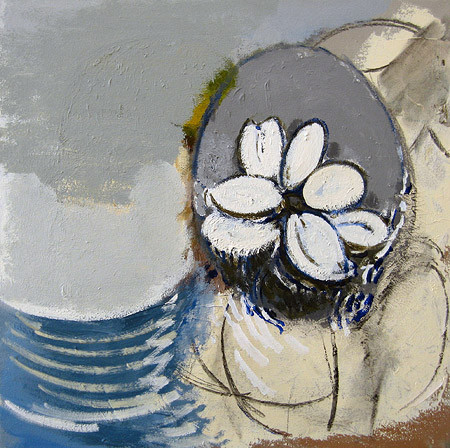Neal Tait
15 Nov - 12 Dec 2008
NEAL TAIT
November 15th 2008 – December 12th 2008
Opening: Friday, November 14th, 7pm – 10pm
The ideal painting is continually open. (Neal Tait)
Neal Tait does not narrate, he foreshadows.
The certainty in his paintings is as uncertain as the space of imagination is infinite. In the work with transitions and spaces he consequently understands to make no commitment of any kind.
His paintings are connected through a muted chart of colour range of earth and pastel tones on a relatively small format, which makes them seem like cabinet pieces. Most of the portraits are blurry to faceless and detract themselves from clarity and further identification. The physiognomy seems as if erased or belched, the eyes are often repainted. Few details emerge instead: A pale red mouth, slightly open. Gestures like an outstretched arm or a reclined back. Downcast eyelids that look more inside themselves than out into the world. With Tait, the classical genre portraits, still lifes and landscapes go into symbiosis and the transition from abstraction to figuration is fluent. That way a mountain formation created by few, in terms of colour offset, strokes of the brush or an accumulation of body parts can persist.
Dissolutions and disfigurations go so far that the persons turn into still lifes and the facial expressions into landscapes. A head becomes a bust and a body a cone – transformations that are reminiscent of the Pittura metafisica. Neal Taits painted collages dissolve usual contexts and are recomposed into something new. The defragmentation that is essential for every metamorphoses is not unusual to stay visible: heads without torsos, torsos without heads, objects melt away and strangely lifeless animal bodies are testimony for left wounds, whose cause stays invisible. A sensitive beauty, grace, but also vulnerability lies in the pictures, which seem as if a haze of oblivion lay on them.
Nothing is logical, everything seems concentrated and surreal – Tait paints like we dream. The artist uses found or self made photographies as drafts, personal experiences or reports, relicts in a way, which already hold their own story and the spirits of the past. Time, contemplation and memory play a big role in the works, which often take a long time and concentrated working to be produced and come very close to Luc Tuymans, Michaël Borremans or even Marlene Dumas. The results seem more left alone than finished and refer symbol like to life itself, which offers more questions than answers and in which a new perspective on things sometimes results in more than old customs.
Carla Orthen.
November 15th 2008 – December 12th 2008
Opening: Friday, November 14th, 7pm – 10pm
The ideal painting is continually open. (Neal Tait)
Neal Tait does not narrate, he foreshadows.
The certainty in his paintings is as uncertain as the space of imagination is infinite. In the work with transitions and spaces he consequently understands to make no commitment of any kind.
His paintings are connected through a muted chart of colour range of earth and pastel tones on a relatively small format, which makes them seem like cabinet pieces. Most of the portraits are blurry to faceless and detract themselves from clarity and further identification. The physiognomy seems as if erased or belched, the eyes are often repainted. Few details emerge instead: A pale red mouth, slightly open. Gestures like an outstretched arm or a reclined back. Downcast eyelids that look more inside themselves than out into the world. With Tait, the classical genre portraits, still lifes and landscapes go into symbiosis and the transition from abstraction to figuration is fluent. That way a mountain formation created by few, in terms of colour offset, strokes of the brush or an accumulation of body parts can persist.
Dissolutions and disfigurations go so far that the persons turn into still lifes and the facial expressions into landscapes. A head becomes a bust and a body a cone – transformations that are reminiscent of the Pittura metafisica. Neal Taits painted collages dissolve usual contexts and are recomposed into something new. The defragmentation that is essential for every metamorphoses is not unusual to stay visible: heads without torsos, torsos without heads, objects melt away and strangely lifeless animal bodies are testimony for left wounds, whose cause stays invisible. A sensitive beauty, grace, but also vulnerability lies in the pictures, which seem as if a haze of oblivion lay on them.
Nothing is logical, everything seems concentrated and surreal – Tait paints like we dream. The artist uses found or self made photographies as drafts, personal experiences or reports, relicts in a way, which already hold their own story and the spirits of the past. Time, contemplation and memory play a big role in the works, which often take a long time and concentrated working to be produced and come very close to Luc Tuymans, Michaël Borremans or even Marlene Dumas. The results seem more left alone than finished and refer symbol like to life itself, which offers more questions than answers and in which a new perspective on things sometimes results in more than old customs.
Carla Orthen.

